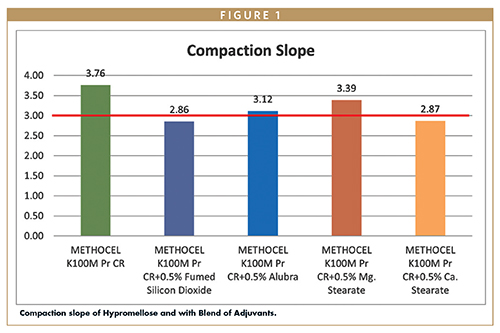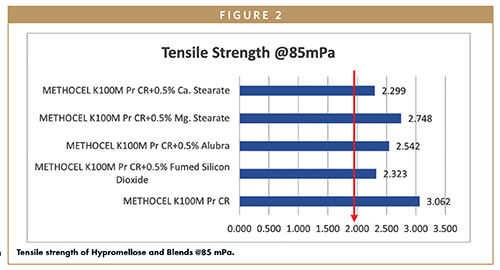Issue:October 2022
EXCIPIENT COMPACTION STUDY - Developing a Reliable Controlled-Release Polymer Using a Compaction Simulator
INTRODUCTION
To keep pace with pharmaceutical industry trends, drug developers are looking to save time, improve efficiency, reduce cost, and respond quickly to market changes. Understanding the various techniques of continuous manufacturing processes is critical to developing robust, stable drug formulations. The study of polymer behaviors in the presence of various adjuvants and flow aids plays an important role in formulation development, stability, tensile strength, and efficacy with respect to final dosage forms. This is especially true for controlled-release formulations.
Controlled-release tablets help improve patient compliance and therapeutic outcomes. These dosage forms last longer, which reduces dosage frequency. And, because the active pharmaceutical ingredient (API) is released more slowly, there is a decreased chance of noticeable side effects. Depending on the manufacturers’ desired drug-release profile, formulators have several advantages to consider when developing controlled-release tablets.
Drug manufacturers can simplify the production of controlled-release tablets by using direct compression. Granulation is a time-consuming technique that, while effective, can lead to product cross-contamination and product loss during processing. In fact, granulation is more costly than direct compression in terms of both time and expense. Direct compression, on the other hand, is a simple and effective way to produce tablets. A manufacturer can blend an API with excipients, followed by compression, which makes the product easy to process. No additional steps, such as drying or sieving, are required. But not all excipients hold up well during this process, which makes the selection of ingredients even more critical.
By using METHOCEL™ (Hypromellose) polymeric excipients in oral solid dosage matrix tablet formulations, quality, value, and robust physical properties attributes can be achieved. These polymers, which have been used in the industry for 70 years, are used in a wide range of applications, such as immediate-release, controlled-release, coating wet granulation, and direct compression. Advanced polymeric excipients are available in various grades based on viscosity and can be a substitute for different ingredients. The water-soluble polymer offers exceptional flexibility and a broad range of properties typically not found in other water-soluble polymers, making it an ideal candidate for continuous manufacturing.
Continuous manufacturing is on the rise and helps manufacturers lower production costs and time, while increasing margins. The process has become a massive resource-saving technique in pharmaceutical manufacturing. Maintaining quality and consistency in continuous manufacturing batches improves drug efficacy. In matrix-controlled-release applications, direct compression can be an effective, affordable option. METHOCEL™ DC2 can be used to modify particle morphology, resulting in improved power flow without the use of additives. These advanced polymeric excipients can be used to modify particle morphology to improve power flow without any additives, resulting in excellent processability when it comes to improved content uniformity and tablet weight, at elevated tablet press speed. Tablet tensile strength is another essential consideration with respect to ingredient compatibility. Products must possess the appropriate strength to avoid crumbling or chipping throughout all stages of delivery.
The pharmaceutical industry continues to focus on the innovation of models or processes that can help predict polymer and API behavior under various processing conditions. By facilitating a compaction simulator, formulators can use the research results to better understand how these processes work using various formulations and compaction weight and learn what to expect when a powder is being pressed into tablets. Being able to adjust nimbly and accurately using a variety of processing methods helps formulators stay ahead of shifting manufacturing trends.
PRODUCTION PROCESS
Hypromellose is a widely accepted polymer for controlled-release applications; it provides the flexibility needed for formulation scientists to modulate drug release for desired therapeutic effect and duration. This study evaluates a compaction simulator to understand the compatibility of polymers, and the effect of tableting pressure on polymer’s physical properties.
The compaction simulator is designed specifically for a detailed study of the compaction characteristics of powder, while simulating the tableting process using different makes/models of tablet compression machines. The simulator helps formulators understand the compaction process in-depth and helps scientists overcome challenges during scale-up stage. The powder is then compressed into tablets at multiple production speeds using the simulating feature. The simulator uses automatic Heckel analysis and automatic Energy and Power analysis to measure various parameters, such as applied pressure, compression pressure, yield pressure, and more. These features help simulate the tablet machine at manufacturing level and compress the tablets in a predictive pattern to avoid future manufacturing challenges.
This study focuses on the compatibility study of METHOCEL™ K100M Pr CR using an ESH Compaction stimulator from Pheonix Materials Testing Ltd., along with commonly used adjuvants or flow aids under various compaction pressure. The effects of various parameters –such as compaction forces, tableting pressure, tensile strength, and ejection force on compacts – were also investigated.
METHODOLOGY
The advanced neat polymer – with adjuvants such as Calcium Stearate, Magnesium Stearate, or fumed Silicon dioxide – was used to conduct blend studies that contain sets of 5 sequences; each sequence contains 5 tablets. They were sifted through 60 mesh, with material blended in a 0.5-L capacity conta blender for 5 minutes at 15-16 rpm.
For each set of the experiment, the compact weight was kept at 500 mg. For adjuvants, 0.5% w/w of the tablet weight was taken and blended with a polymer for further study. Approximately 500 mg of polymer or polymer blends was filled in a 13-mm D type flat surface single punch on the Compaction Simulator. The parameters of each tablet, including hardness, diameter, thickness, and tablet weight, were recorded. The data was then fed to compaction simulator software, which utilizes Heckel analysis and compaction slope, compaction force, tableting pressure, and ejection force, and then recorded.
RESULTS & DISCUSSION
As the simulator uses Heckel analysis, the significance of Heckel constant k is related to the reciprocal of the mean yield pressure, which is the minimum pressure required to cause deformation of the material under compression. A large value of the Heckel constant indicates the onset of plastic deformation at relatively low pressure.
The compaction simulator produces a compaction slope for each set of the experiment and extrapolates the slope at two compression forces, such as @85 mPa and @100 mPa. The higher the slope value, the better material compatibility is seen; the various parameters were noted, including compression force, applied pressure, hardness, and tensile strength.
Compaction Slope
Here, the compaction simulator produces a compaction slope for each set of the experiment. As shown in Figure 1, the advanced neat polymer had the highest slope value, indicative of excellent compatibility.
Per the literature, the higher the compaction slope of a Heckel analysis, the lower the pressure it requires for compaction. The advanced neat polymer shows the highest slope, ie, more than 3.0, which is indicative of low yield pressure to start the deformities of polymer structure, resulting in improved material compatibility.1

Tensile Strength
Excipients, such as diluents, fillers, and binders, play a significant role in improving a formulation’s content uniformity, as well as the resulting tablet’s tensile strength. High- dose tablets may lack sufficient tensile strength if the API is not easily compressible, while low-dose formulations may be difficult to blend uniformly.
For small-scale manufacturing, generally, tensile strength should be more than 1 mPa. For commercial-scale production, tensile strength should be more than 1.7 mPa to sustain the down processing, such as tablet coating or packaging.2 This study indicates tablets produced with Hypromellose have the highest tensile strength (more than 2.0 mPa) to sustain various down processing steps.
The EHS Compaction simulator extrapolates the data and calculates tensile strength of polymer/polymer blend @ 85 mPa.
Tableting Pressure Versus Tensile Strength
The machine automatically selects different tableting pressures based on the polymer and blend properties. During compression, the polymer and its blend are subjected to increasing applied and compression pressure. The advanced neat polymer shows good compatibility at all pressures without any tableting issues. Figure 3 highlights a plot comparison between tableting pressure and tensile strength. For most of the combinations, there were no tableting issues – such as chipping, capping, friability observed – except for Magnesium Stearate at higher tableting pressure. The polymer and its blend were able to sustain the higher tableting pressures.

Hypromellose with a flow aid, such as magnesium stearate, calcium stearate, and sodium stearyl fumarate (SSF), showed an improved, higher tensile strength. At higher tableting pressure, SSF was found to produce good compaction, whereas Calcium Stearate @100 mPa tableting pressure experienced chipping and capping (Figures 3 & 4).


CONCLUSION
These study results show that through polymer chemistry, it is viable to effectively manufacture matrix tablets via a simple direct compression method; and Hypromellose has impressive compatibility at various compression forces. The simulator results show high tablet tensile strength, low tablet friability, and good content uniformity. The excellent flow properties provide processability in direct compression, the preferred industry method. The propranolol HCl release profile from the advanced neat polymer matrix tablets are similar and remained stable following 1 month of storage, under accelerated stability conditions. Therefore, the reproducibility in tablet properties can be higher for direct compression.
The tensile strength of advanced neat polymers was found compatible – along with flow aids such as SSF, fumed silicon dioxide, and magnesium Stearate – without any chipping or capping. Blends with Calcium stearate led to lower compact hardness and capping at higher tableting pressure. However, the hardness of all compacts with other combinations was strong enough to withstand further stress of coating, packaging, and shipping.
Continuous manufacturing is a growing trend and resource-saving technique in pharmaceutical manufacturing. As such, selecting flexible excipients is the best way for formulators to optimize operations and avoid malfunction during the manufacturing process. This study shows co-processed excipients, such as Hypromellose, can help solve many continuous manufacturing issues and allow for any easy transition from batch manufacturing. There is shortened development time and up to 60% lowered manufacturing costs through the elimination of the wet granulation process.
Importance of Excipients & Expertise
Formulators whose direct compression tableting operations are faced with particle segregation, poor API content uniformity, and plugging or blocking in the manufacturing process should seek out an excipient that improves powder flow and tablet compatibility, like advanced neat polymers.
To reduce manufacturing steps while producing a quality product, it is also important to choose an excipient that offers functionalities that exceed or build upon traditional excipient blends. The correct excipient can help manufacturers avoid ingredient segregation during the blending process, improve flow, and achieve proper lubrication for one-step mixing. Applying an accelerated formula strategy is one of the best ways to keep savvy formulators ahead of the industry curve.
ACKNOWLEDGEMENT
The authors wish to thank Drs. Sangmesh Torne and Tejas Gunjikar, IFF, Mumbai, India, for their help with this study.
REFERENCES
- Yadav, P., Kumar Sahdev, A. (2018). Physics of tablet with compaction and compression process for novel drug dosage form. International Journal of Advanced Science and Research, 3(4),28-34.
- Pitt, K.G., Heasley, M.G. (2013). Determination of the tensile strength of elongated tablets. Powder Technology, 238,169-175.

Gopeshkumar Singh is an application development and innovation scientist at IFF based out of Mumbai, India. He earned his Master’s degree from NMIMS University. His area of expertise is in controlled-release matrix formulations, delayed-release, hot melt extrusion and twin screw granulation technologies.

Ajit Bhagat is a senior technologist at IFF, based at Hyderabad, India. He earned his Bachelor’s degree from Mumbai University and is well-trained in equipment operations and experimental design for formulation development.
Total Page Views: 4644










